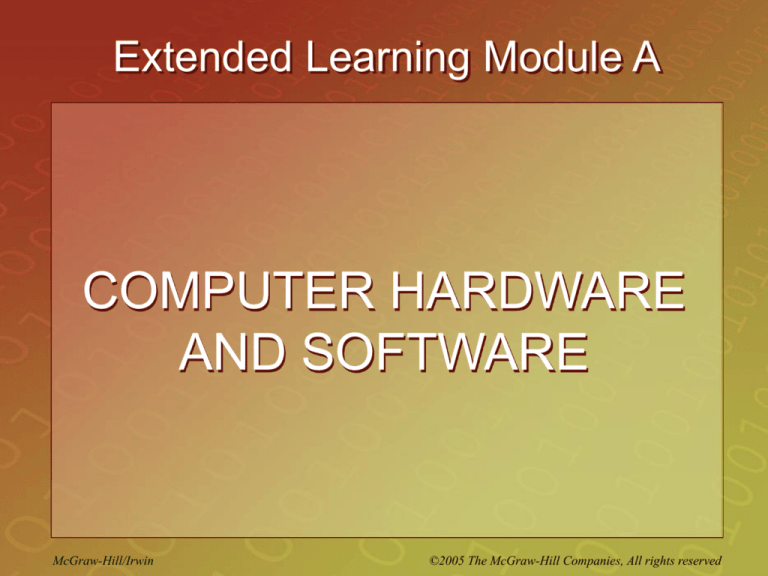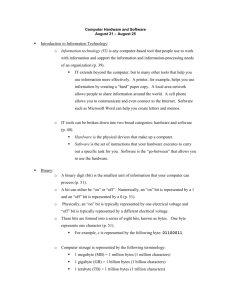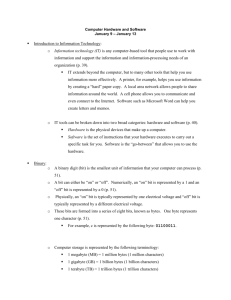
Extended Learning Module A
COMPUTER HARDWARE
AND SOFTWARE
McGraw-Hill/Irwin
©2005 The McGraw-Hill Companies, All rights reserved
INTRODUCTION
• Information technology (IT) – any
computer-based tool that people use to work
with information and support the information
and information-processing needs of an
organization
A-2
A QUICK TOUR OF TECHNOLOGY
• Hardware – the physical devices that make
up a computer (often referred to as the
computer system)
• Software – the set of instruction that your
hardware executes to carry out a specific
task for you
A-3
Six Categories of Hardware
1. Input device – tool that you use to enter
information and commands
2. Output device – tool you use to hear, see,
hear, or otherwise recognize the results of
your information-processing requests
3. Storage device – tool you use to store
information for use at a later date
A-4
Six Categories of Hardware
3. Central processing unit (CPU) – the
hardware that interprets and executes
software and coordinates all hardware
4. Random access memory (RAM) –
temporary holding area for information, as
well as system and application software
instructions
A-5
Six Categories of Hardware
5. Telecommunications device – tool you
use to send information to and receive it
from another person or computer in a
network
6. Connecting hardware – any hardware that
lets you connect peripherals to your
computer, such as cables, ports, expansion
boards, etc.
A-6
Three Major Categories of Software
1. Application software – enables you to
solve specific problems or perform
specific tasks
A-7
Three Major Categories of Software
2. System software - handles tasks specific to
technology management and coordinates
the interaction of all technology devices
– Operating system software – controls
application software and manages hardware
devices
A-8
Three Major Categories of Software
3. Utility software – provides additional
functionality to your operating system
software
A-9
CATEGORIES OF COMPUTERS BY
SIZE
• Personal digital assistant (PDA) – small
hand-held computer for personal tasks like
appointment scheduling and address book
maintenance
• Tablet PC – pen-based computer with the
functionality of a notebook or desktop
A-10
CATEGORIES OF COMPUTERS BY
SIZE
• Notebook computer – small, portable, fully
functional, battery-powered computer
• Desktop computer – most popular type of
personal computer
A-11
Minicomputers, Mainframes, and
Supercomputers
• Minicomputer (mid-range computer) –
meets needs of several people
simultaneously in a small or medium-sized
business
• Mainframe computer – meets needs of
hundreds of people in a large business
• Supercomputer – fastest, most powerful,
and most expensive type of computer
A-12
SOFTWARE – YOUR INTELLECTUAL
INTERFACE
• Personal productivity software – helps you
perform personal tasks
– Writing memos
– Creating graphs
– Creating slide presentations
• Software suite – several applications
bundled together (usually productivity
software)
A-13
Application Software
• Word processing – helps you create letters,
memos, and other basic documents
• Spreadsheet – helps you work with
numbers, perform calculations and create
graphs
A-14
Application Software
• Presentation – helps you create and edit
information that will appear in slides
• Desktop publishing – extends word
processing by including design and
formatting techniques to enhance the
appearance of the document
A-15
Application Software
• Personal information management (PIM) –
helps you create and maintain to-do lists,
appointments, calendars, etc.
• Personal finance – helps you maintain your
checkbook and handle other personal finance
tasks
A-16
Application Software
• Web authoring – helps you design and
develop Web sites
• Graphics – helps you create and edit photos
and art
• Communications – helps you communicate
with others
A-17
Application Software
• Database management system (DBMS) –
helps you specify the logical organization for
a database; access and use the information
within a database
A-18
Vertical and Horizontal Market Software
• Vertical market software – application
software for a specific industry
– Patient-scheduling software
– Restaurant management software
• Horizontal market software – application
software suitable for use in many industries
– Payroll, inventory, and billing
A-19
System Software
• Operating system software
– Microsoft Windows XP Home – update of Office
– Microsoft Windows XP Pro – update of Office
Pro
– Mac OS – Operating system for Macs
– Linux – powerful open-source operating system
A-20
Multitasking
• Multitasking
– working with
more than one
application at
a time
A-21
Utility Software
• Anti-virus software – detects and removes
or quarantines computer viruses
• Crash-proof software – helps save
information if your system crashes
• Uninstaller software – removes software
from your hard disk
• Disk optimization software – organizes
information on your hard disk
A-22
HARDWARE: YOUR PHYSICAL
INTERFACE
• Representation of information
– Binary digit (bit) – smallest unit of information
your computer can process
– Byte – eight bits or the number of bits it takes to
represent one natural character
– ASCII (American Standard Code for
Information Interchange) – coding system that
personal computers use
A-23
Categories of Input Devices
A-24
Input Devices for Information and
Commands
• Keyboards – most frequently input devices
for notebooks and desktops to enter
information and commands
• Stylus – most frequently used input devices
for PDAs and tablet PCs to enter information
and commands
A-25
Input Devices for Commands
• Pointing Device – used to input commands
– Mouse – device you use to click on icons and
buttons
– Trackball – similar to a mechanical mouse, but
with the ball on top
A-26
Input Devices for Commands
– Touchpad – dark rectangle you use to
move the cursor with your finger
– Pointing stick – a little rod, used mostly
on notebooks
A-27
Game Controllers
• Game controller – used for gaming to
control screen action
– Gaming wheel – steering wheel and foot pedals
for virtual driving
A-28
Game Controllers
– Joystick – controls action with a vertical handle
and programmable buttons
– Gamepad – device with programmable buttons,
thumb sticks, and a directional pad
A-29
Scanners
• Scanners – used to convert information that
exists in visible form into electronic form
– Image scanner – captures images, photos, text,
and artwork
– Bar code scanner – reads information in the form
of vertical bars
A-30
Scanners
– Optical mark reader – detects the presence or
absence of a mark
– Optical character reader – reads characters that
appear on paper or sales tag (used in POS
systems)
– Biometric scanner – scans a human physical
attribute, like a fingerprint or iris, for security
purposes
A-31
Digital Cameras
• Digital camera – captures still image or
video as a series of 1s and 0s
– Digital still camera – digitally captures still
images in varying resolutions
– Digital video camera – captures video digitally
– Webcam – captures digital video for the Web
A-32
Categories of Output Devices
A-33
Monitors
• CRT – monitors that look like traditional TV
sets
• Flat-panel display – thin, lightweight
monitors that take up much less space than
CRTs
A-34
Monitors
• Two types of flat-panel displays
– Liquid crystal display (LCD) monitor – sends
electricity through crystallized liquid between
layers of glass or plastic
– Gas plasma display – sends electricity through
gas trapped between layers of glass or plastic
A-35
Important Considerations
• Viewable image size (VIS) – the size of the
image on a monitor
• Resolution of a screen – the number of
pixels it has
• Pixels (picture elements) – the dots that
make up the image
• Dot pitch – the distance between the centers
of two like-colored pixels
A-36
Printers
• Resolution of a printer – the number of dots
per square inch (dpi) it produces
• Types
– Inkjet printer – makes images by forcing ink
through nozzles
– Laser printer – forms images using the same
electrostatic process that photocopiers use
– Multifunction printer – scan, copy, and fax, as
well as print
A-37
Categories of Storage Devices
A-38
Capacity of Storage Devices
• Megabyte (MB or M or Meg) – about 1
million bytes
• Gigabyte (GB or Gig) – about 1 billion bytes
• Terabyte (TB) – about 1 trillion bytes
A-39
Magnetic Storage Media
• Hard disk – magnetic storage with one or
more thin metal platters sealed inside the
drive
• Zip disk – high capacity (100 MB, 250 MB,
and 750 MB) removable storage medium
• Floppy disk – removable storage medium
that holds 1.44 MB
A-40
Optical (or Laser) Storage Media
• Optical storage media – plastic discs on
which information is stored, deleted, and
changed using laser technology
• Two types
– CDs
– DVDs
A-41
CDs
• CD-ROM (compact disc read-only
memory) – information cannot be changed
• CD-R (compact disc – recordable) – write
one time only
• CD-RW (compact disc – rewritable) – save,
change, and delete files repeatedly
A-42
DVDs
• DVD-ROM – high capacity; information
cannot be changed
• DVD-R or DVD+R (DVD – recordable) –
high capacity; write one time only
• DVD-RW or DVD+R (depending on
manufacturer) – save, change, delete
repeatedly
A-43
Flash Memory Devices and Cards
• Flash memory device – very small storage
device that plugs into USB port
• Flash memory card – high capacity storage
laminated inside a small piece of plastic
A-44
Flash Memory Cards
• xD-Picture (xD) card – rectangular; smaller
than a penny and about as thick with one
curved side
• Secure Digital (SD) card and
MultiMediaCard (MMC) – look the same but
SD has copy protection; are both larger and
thicker than a quarter (but rectangular)
A-45
Flash Memory Cards
• CompactFlash (CF) card – almost square;
larger than a half-dollar
• SmartMedia (SM) card – rectangular; longer
than CF
• Memory Stick Media card – elongated card
as wide as a penny developed by Sony
A-46
CPU and RAM
• CPU and RAM work together to form the
brain of your computer
• CPU speed measured in gigahertz (GHz)
– GHz – number of billions of CPU cycles per
second
– CPU (machine) cycle – retrieve, decode, and
execute instruction, then return result to RAM if
necessary
A-47
CPU Components
• CPU components
– Control unit – directs what happens in the CPU
and the rest of your computer
– Arithmetic logic unit (ALU) – performs
arithmetic, comparison, and logic operations
– CPU cache – CPU memory where instructions
wait until they’re needed
– CPU clock – beats to keep instructions and
information moving in synchronized fashion
A-48
System Bus
• System bus – electrical pathways that move
information between motherboard
components, especially between CPU and
RAM
A-49
CPU and RAM at Work
A-50
CPU (Machine) Cycle
1. Retrieve: The control unit sends to RAM for
the instructions and information it needs
2. Decode: CPU gets the instruction out of
cache and examines it to see what to do
3. Execute: Does what the instruction says to
do
4. Store: Sends the result of processing to be
stored in RAM if necessary
A-51
Notebook CPUs and RAM
• Mobile CPU – type of CPU that changes
speed, and therefore power consumption, in
response to fluctuation in use
• RAM for notebooks comes in smaller
modules than RAM for desktops
A-52
Categories of Connectors and Ports
A-53
Connecting Hardware Outside to the
Hardware Inside
• Port – place on your system unit, monitor, or
keyboard through which information and
instructions flow to and from computer
A-54
Connecting Hardware Outside to the
Hardware Inside
• Some ports work with plug-and-play and hotswap ports and devices
– Plug and play – operating system feature that
finds and installs the driver for the device
– Hot swap – operating system feature that allows
you to plug or unplug a device while the computer
is running
A-55
Ports
• USB (universal serial bus) port – fits small,
flat, plug-and-play, hot-swap USB connectors
• Firewire port (IEEE1394 or I-Link) – fits hotswap, plug-and-play Firewire connectors
A-56
Ports
• PS/2 port – fits PS/2 connectors (used for
keyboards and mice)
• Parallel port – fits parallel large flat parallel
connectors found on printers
A-57
Wireless Connections
• Infrared IR or IrDA (infrared data
association) – uses red light to send and
receive information
• Bluetooth – transmits information as radio
waves for a distance of 30 feet
• WiFi (wireless fidelity) or IEEE 802.11a, b,
or g – transmits information as radio waves
for a distance of up to 300 feet
A-58
Expansion Cards and Slots
• Expansion card (board) – circuit board that
you insert into the expansion slot and
connect to a peripheral device
• Expansion slot – long skinny socket on the
motherboard for expansion card
• Expansion bus – pathways along which
information moves between devices (outside
the motherboard) and the CPU
A-59
Expansion for Notebooks
• PC Card – expansion card for a notebook
• PC Card slot – opening on side or front of a
notebook, into which you plug a PC Card
A-60







